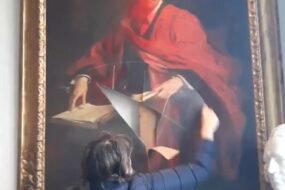
The election of Leo XIV to the papacy has put an unexpected spotlight on one of the most unusual treasures of Catholic religious art in the greater Washington area.
The painting, “An Allegory of St. Rosa of Lima,” is one of the art works on view in a new installation of Latin America Art that has just opened at The Walters Art Museum in Baltimore.
The newly elevated pontiff is American in the widest sense of the word. A Chicago native, he spent decades as a missionary and later bishop in Peru, where he acquired dual citizenship. The “St. Rosa” oil on canvas painting originated sometime between 1730 and 1760 in the Viceroyalty of Peru, which encompassed all of modern Peru and Bolivia during the colonial era.
The picture was probably created by a painter in the Cuzco School, begun by a circle of artists from Italy who settled in the Andean region of Cuzco around 1574. Cuzco was not only the headquarters of religious orders in the Viceroyalty; it was also the ancient capital of the Inca Empire.
Rosa of Lima, the first canonized saint of the Americas, was born Isabel Flores de Oliva in 1586 in Lima. Her father was a Spanish soldier and her mother, a “criolla” (American-born) native of Lima. As a young girl she emulated the Dominican tertiary St. Catherine of Siena, fasting three times a week and performing secret penances as well as permanently abstaining from meat. Since she was revered for helping the sick and hungry of her community, it was fitting that the Baltimore diocesan charity Esperanza, devoted to helping immigrants, was well represented at the festive opening of the permanent Latin American exhibit at the Walters May 17.
Rosa sold her fine needlework and took flowers that she grew to market, to help her family and the poor of Lima. When her father forbade her to become nun, she donned the habit of a Dominican tertiary, also known as the third order, for lay Catholics. She got her nickname “Rose” when a servant saw her infant face transformed into a rose. Canonized in 1671, Rosa became known as a patron of embroidery, gardening and florists.
The Walters painting is a 5-foot-tall canvas based on a widely circulated European engraving of 1711 that formed the cover page of a collection of sonnets in praise of St. Rosa by the Spanish-born poet Oviedo y Herrera. In the print (also acquired by the Walters but not on view), Rosa of Lima is portrayed from the waist up emerging from a giant rose, wearing a dark habit and contemplating an image of the infant Christ. Below her are two figures. On the left is an allegorical female figure with a feathered headdress and quiver of arrows, which by that time were standard ways of symbolizing the Americas. This figure, nude in the print, is replicated in the painting but clothed in a blue robe.
On the right side of the print there was a portrait of the poet who wrote the sonnets. But in the Walters painting he has been changed into a stylized Inca ruler. In a pose of deep reverence, the ruler has a darker skin tone from the other figures and wears a “tocapu,” a tunic with square patterns. Over his shoulder he wears a “yacolla” (cloak) associated with men of importance. He also wears a colored band around his forehead that includes a red fringe, both parts of the Inca crown. Above his crown sprout three flowers, the “cantuta” associated with nobility since pre-Columbian times and still the national flower of Peru and Bolivia. These details would have been recognized instantly as marking the man as a member of the Inca royal family.
This symbolism was very important to criollos, people of Spanish descent born in the Americas but banned from high levels in the bureaucracy. By evoking the ancient Inca monarchy, they were proclaiming their equality with other kingdoms integrated into the universal Spanish monarchy.
Such pictures were banned after the Tupac Amaru uprising of 1780-83 and many were destroyed. Hence the Walters painting, probably owned by a private family, is a rare survivor.
The Walters Latin American Art exhibit also includes a tiny carved wooden lantern showing the Crucifixion and Deposition of Christ from the Cross. This object is only 2 inches high but with an exotic element that likely came from Mexico — iridescent blue-to-emerald green hummingbird feathers on the side of the box. Feather mosaics were a feature of ancient Mexican art, an indigenous tradition that was melded into Christian art.
Hamerman writes from Reston.











